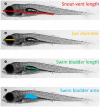Early life disruption of the microbiota affects organ development and cytokine gene expression in threespine stickleback
- PMID: 32970813
- PMCID: PMC10388389
- DOI: 10.1093/icb/icaa136
Early life disruption of the microbiota affects organ development and cytokine gene expression in threespine stickleback
Abstract
The microbiota that inhabits vertebrates exerts strong effects on host physiology and can be crucial to the development of a normal phenotype. This includes development of the immune system, somatic growth and maintenance, and morphogenesis. However, the genetic background of the host can also affect these life history traits. To this end, we investigated the effects of the microbiota on growth, development, and immune gene expression on two populations of threespine stickleback (Gasterosteus aculeatus), one anadromous and one freshwater. We tested the hypotheses that microbial colonization and the genetic background of the host would affect survival, cytokine gene expression, growth, and development. We raised in vitro crosses of stickleback larvae with and without conventional microbiota. We then exposed all these treatments to Vibrio anguillarum, a potential fish pathogen, in a full factorial design. We found stickleback raised without conventional microbiota had smaller swim bladders relative to those raised with conventional microbiota. Stickleback raised with conventional microbiota exhibited small increases in cytokine gene expression. We found no differences in growth or survival regardless of treatment. These results are consistent with other investigations that show microbiota disruption, in early life, can alter host organ and tissue development and immune responses.
© The Author(s) 2020. Published by Oxford University Press on behalf of the Society for Integrative and Comparative Biology.
Figures




References
-
- Arendt JD. 1997. Adaptive intrinsic growth rates: an integration across taxa. Q Rev Biol 72:149–77.
-
- Austin B, Austin DA. 2012. Bacterial fish pathogens. Dordrecht, The Netherlands: Springer.
-
- Bates D, Maechler M, Bolker B, Walker S. 2019. Fitting Linear Mixed-Effects Models Using lme4. J Stat Softw 67:1–48.
Grants and funding
LinkOut - more resources
Full Text Sources

